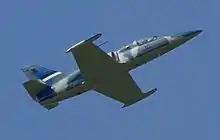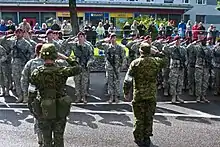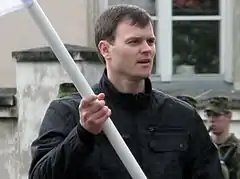Võidupüha
Võidupüha or Victory Day in English or the Victory Day in the Battle of Võnnu in Estonian is a public holiday in Estonia which takes on June 23. The holiday has been celebrated since 1934 and marks the victory of Estonia and neighboring Latvia in the Battle of Cēsis against the Baltische Landeswehr on June 23, 1919.

History
The battle was part of the 1918–1920 Estonian Liberation War of Independence, in which the new Estonian government was fought the Soviet Union's Red Army and the Baltische Landeswehr, which consisted of Baltic German nobility from Courland and the Governorate of Livonia who served the German Empire and aimed to establish the United Baltic Duchy. After the fighting began On 19 June, the combined force of the 3rd Division, the Kuperjanov Infantry Partisian Battalion and the Latvian Northern Brigade pushed held out with reinforcements arriving On 21 June and despite the fact that they did not have the advantage when it came to weaponry (German troops had 5,500–6,300 infantry, 500–600 cavalry as well as a high number of cannons and mortars). On 23 June, after pushing back on the last of the German attacks, the combined contingent staged a large counter-attack which resulted in the recapture of Cēsis (Võnnu in Estonian). After this occurred, Major General Ernst Põdder ordered his day-to-day command of the day that "the victories won over our stagnant and surrendered enemy, in cities and in the countryside, flags and armed units in the local garrisons were set up."[1] On 16 February 1934, the Riigikogu decided to turn the 23 June into a national holiday. The holiday was banned by the new Soviet authorities in Estonia after the USSR re-established Soviet rule over Estonia in 1944. It was also banned by the previous German occupation of Estonia during World War II. It became legal to celebrate Võidupüha again after Estonia regained its independence.[2] The first celebrations of the holiday took place in 1992, in the Kadriorg Palace yard.[3]
Observances

Joint celebrations are observed by both the Estonian Defence Forces and the Latvian National Armed Forces being that it was a joint victory between the two countries. Despite this, Estonia celebrates Victory Day more as a national holiday and event unlike their Latvian counterparts. Celebrations of Võidupüha has been organized by the Estonian Defence League since 2000. Ceremonially, the holiday is also tied to St John's Day (Jaaniõhtu) on June 24, celebrating the summer solstice observances and the Nativity of Saint John the Baptist.
The traditional lighting of a fire by the Estonian President on the morning of Victory Day was restored after the Soviet occupation From this fire, the flame of independence would be carried across the country to light the many other bonfires in other cities. By Estonian laws, all national symbols must be present, which requires that the state flags are not to be lowered on any government buildings during the night that passes between these two days.
Parades

Annual military parades have taken place in honor of Võidupüha in different cities of Estonia, with the President of Estonia presiding over the event as Honorary Commander-in-Chief of the Defense Forces.
The following Võidupüha parades have taken place over the years:[4]
- 1994 Tartu
- 1995 Pärnu
- 1996 Narva
- 1997 Võru
- 1998 Viljandi
- 1999 Valga
- 2000 Haapsalu
- 2001 Pärnu
- 2002 Põlva
- 2003 Jõhvi
- 2004 Rakvere
- 2005 Paide
- 2006 Saaremaa - The first Fleet Review (Mereparaad) of the Estonian Navy in Estonian history was conducted during the 2006 parade.[5]
- 2007 Rapla
- 2008 Tallinn
- 2009 Jõgeva
- 2010 Viljandi
- 2011 Tartu[6]
- 2012 Pärnu - It was the biggest parade since 1992. It was the third time Parnu has hosted the parade.[7]
- 2013 Haapsalu
- 2014 Valga
- 2015 Kärdla - The 2015 parade also saw a rising number of military contingents from NATO countries take part, including Latvia, the United States, Finland, Poland and Sweden.
- 2016 Võru - Aside from American and Latvian troops, the parade also featured new foreign contingents from Lithuania and Denmark. The Pipe Band of the Sakala Subdivision of Defence League performed in the Victory Day parade alongside the Band of the Estonian Defence Forces to provide musical accompaniment.[8][9]
- 2017 Rakvere
- 2018 Tallinn - It was attended by Georgian president Giorgi Margvelashvili and Icelandic president Guðni Thorlacius Jóhannesson.[10][11]
- 2019 Tartu - It marked the centennial jubilee of the Battle of Cēsis. The parade was for the first time, arranged by service branch instead of district units.[12][13] Aircraft from the Hungarian Air Force and the Royal Air Force also took part in the parade as part of the larger foreign contingents.[14][15]
In 2006, ETV filmed Võidupüha Mereparaad (Victory Day Naval Parade), which was a documentary on the Estonian/NATO naval parade on Võidupüha that year. The 2020 parade was cancelled due to COVID-19.[16]
References
- "Kuidas hakati Võidupüha tähistama". 2012-06-23.
- "День победы в Эстонии". Calend.ru.
- "Kuidas hakati Võidupüha tähistama". 2012-06-23.
- "Võidupüha paraad | ERR | Digihoidla". arhiiv.err.ee.
- "Remembering the Generation of 1918". June 24, 2006.
- "ERR: Järgmine võidupüha paraad toimub Tartus". Delfi. October 30, 2010.
- Times, The Baltic. "Article". m.baltictimes.com.
- Ivar Jõesaar (October 2016). "Sõjatorupilli saamislugu: nüüd, kui Eesti torupill on astunud riigikaitseteenistusse" (in Estonian). Delfi. Retrieved 22 October 2016.
- "Võidupüha paraad Võrus: pärast Ilvese kõnet toovad tunnustatud noorkotkad ja kodutütred pühadetule kõigisse maakondadesse" (in Estonian). Eesti Rahvusringhääling. 23 July 2016. Retrieved 2 June 2017.
- "FOTOD | Vaata, kuidas valmistuti tänaseks aegade suurimaks võidupüha paraadiks". Delfi. June 23, 2018.
- "Georgian President ends visit to Estonia, highlights importance of discussions regarding country's Euro-Atlantic future". Agenda.ge.
- ERR, ERR News, BNS (June 19, 2019). "Over 1,200 uniformed personnel to take part in Victory Day parade". ERR.
- "Estonia holds Victory Day parade - Xinhua | English.news.cn". www.xinhuanet.com.
- "Эстония парадом отметила столетие своей победы над немцами". EADaily.
- "В Тарту прошел парад в честь Дня победы". ERR. June 23, 2019.
- https://news.err.ee/1086478/victory-day-parade-canceled-fires-still-lit-across-estonia